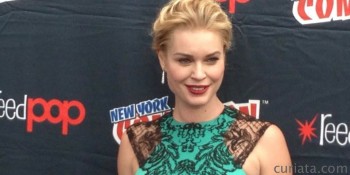TNT is expanding a successful television movie trilogy into a weekly episodic TV series this winter. The cast and executive producer of The Librarians appeared at New York Comic Con last Sunday to preview the series for eager fans and speak with press including Curiata.com.
The Librarian: Quest for the Spear, an original, made-for-TV, action/adventure film, debuted on TNT in December 2004. The movie introduced Flynn Carsen, played by ER veteran Noah Wyle, as the man chosen to be the librarian of a secret archive of powerful objects. Wyle himself has described the films as Indiana Jones — if the role of Jones were played by Don Knotts.
The film was a big success for TNT and was ranked as the No. 1 movie of the year on basic cable. It spawned two sequels, The Librarian: Return to King Solomon’s Mines, which premiered as cable’s No. 1 movie sequel of all time in 2006, and The Librarian: The Curse of the Judas Chalice in 2008.
This December, a decade after the premiere of the first Librarian film, TNT is bringing the Library back with an all-new, 10-episode series. Wyle will return as Flynn, albeit in a reduced, recurring role. John Larroquette stars as the reluctant caretaker of a new cast of Library workers, similar to Bob Newhart‘s role in the movies. The series will feature appearances from Newhart and Jane Curtin, reprising their roles from the films.
Lindy Booth, Christian Kane, John Kim, and Rebecca Romijn round out the cast as characters who work for the Library but — importantly — are not Librarians. The Librarian is a position similar to that of the Slayer in Buffy the Vampire Slayer, in that there is only ever one at a time.
Those four cast members were joined by executive producer John Rogers at NYCC to explain a bit about the series.
“When the show starts, we’re not librarians,” Kane said of his, Booth’s, and Kim’s characters. “We’re next in line.”
If anything were to happen to Wyle’s Librarian, one of their characters could be the next to step into the role. And when the series starts, the lives of all the potential Librarians are in jeopardy.
According to Rogers, you don’t need to have seen any of The Librarian films in order to enjoy the series; everything you need to know will be recapped in the opening.
“We went back and looked at the Eccleston Doctor Who reboot,” Rogers said, referring to the relaunch of the classic British sci-fi series in 2005, nearly 16 years after its last episode. “The trick is don’t explain it: show it. Audiences are smart; genre audiences, in particular, have been watching variations of these things for a long time — they’re smarter than you, they’ll figure it out, you don’t have to spoon-feed them.”
Rogers believes that, at least with the first couple of seasons, a series should be primarily standalone so fans can jump on board at any point without feeling out of the loop.
“It’s cool if you watch one or intermittently, but you’re rewarded if you watch all of them,” Rogers said.
The Librarians was filmed in a relatively short period of time in order to work around Wyle’s schedule and ensure he would be a part of the series. According to Rogers, there was never a question of Wyle’s involvement.
When he first heard of the series, Wyle’s initial reaction was, “But I’m the Librarian,” Rogers told fans.
Wyle won’t appear in every episode, but his absences are a plot point: he’s out on a mission that runs parallel to the main story line of the show.
Romijn plays a counterterrorism agent who is recruited to protect the potential librarians. Romijn describes Eve Baird as a skeptic who was very reluctant to join the team.
“I get invited to work at the library, I don’t know why; I don’t necessarily want the job, but I’ve received this mysterious invitation,” Romijn said. “I am the guardian of the Librarian — he doesn’t want me either.”
Before long, Eve’s job expands beyond protecting the Librarian.
“We discover that the Librarian and the Librarians-in-training are all in danger, and so I become the guardian to the Librarians-in-training as well,” Romijn said. “Early on, I’m in charge of them, and they’re not prepared for the danger out there, and I have to train them … we really become a family.”
Playing the protector of the group wasn’t too difficult for Romijn, as she has portrayed several physically commanding characters in the past — perhaps most famously that of Mystique in the X-Men movies. Last year, Romijn also did a lot of weapons and mixed martial arts training for her role as Michelle Maxwell on TNT’s King & Maxwell.
“Our job is to run around the world and collect dangerous magical artifacts to keep them out of the wrong hands, and there are all these people chasing us and in pursuit,” Romijn said. “I am sort of there to fight them off.”
Romijn’s two favorite episodes of the season are an episode involving fairy tales, which the entire cast seems excited about, and the Christmas episode, featuring guest star Bruce Campbell.
“But the one I can’t wait for the fans to see the most is the finale, because there’s a huge payoff in the finale,” Romijn said.
Romijn is joined in the Library by Kane, who plays Jake Stone, an Oklahoma oil worker with a high IQ and an extensive knowledge of art history. Kane has worked with Rogers, the executive producer, before in his previous role on Leverage. In that series, Rogers tailored the role to include many of Kane’s own interests. Kane acknowledged Rogers did the same for the character of Jake.
“John Rogers wrote the role as an art history major and I was — at the University of Oklahoma, I was an art history major,” Kane said. “So he kind of incorporated that into the character. And the guy’s from Oklahoma, which I am, and my dad is a hard-working, blue-collar oil man. … So he almost started me right there as Christian Kane.”
When he’s not acting, Kane is also a singer and songwriter who has showcased his musical talents on the small screen in the past. So will fans of Kane’s music get to hear him sing on The Librarians as well?
At NYCC, Kane looked around to where Rogers was sitting before answering with a definite “Yes.” Not this season, Kane said, but if the show continues, he is positive viewers will get to hear him sing.
In his previous role as Eliot on Leverage, Kane played the “hitter” of the team — the guy who was always ready for a fight. But while Jake can hold his own in a bar fight, he doesn’t have the technical combat knowledge Eliot had.
“It’s tough for me, because I have to unlearn everything I did for five years on Leverage,” Kane said. However, he’s been enjoying the change of pace. “It’s been fun to walk in someone else’s shoes.”
But that doesn’t mean you won’t ever see Kane fight.
“I told John … why would you fix something that ain’t broke?” Kane said. “Let me just throw punches, man, that’s what I do.”
Rogers assured Kane he’d get to do some fighting, but warned Jake’s skills would need to grow over time.
“So you see me get better at certain things, and you see me picking up things along the way,” Kane said. “I’m sure that, as time goes on, my character will progress.”
Kane compared his character’s potential progress to that of Wyle’s throughout the course of the Librarian movies.
“When the first Librarian came out, Noah Wyle was a dork … now he’s Indiana Jones,” Kane said, concurring with Wyle’s own characterization. “And it was fun to watch Noah progress along that way; now he’s just a badass.”


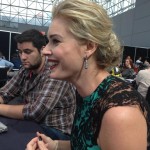

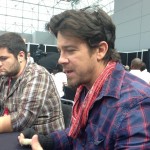

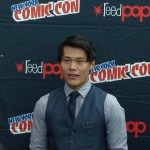
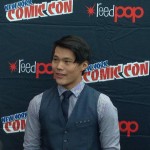
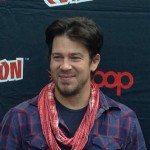
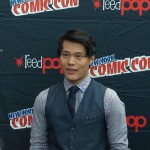
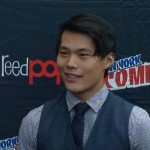
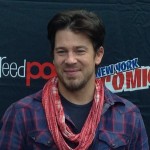
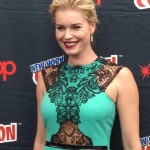
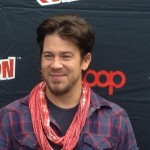
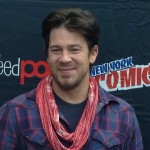

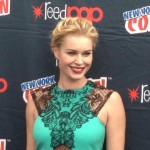
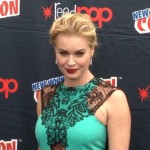
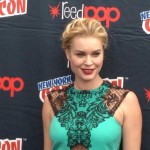
The cast of TNT’s upcoming series The Librarians spoke with Curiata.com and posed for photographs at New York Comic Con last Sunday.
Another character with a special skill set is Cassandra, played by Booth. Cassandra is a synesthete: she has sensory hallucinations related to certain actions.
“All of her senses are sort of cross-wired in her brain: sees numbers as colors, science is music, math smells like breakfast,” Booth said.
Synesthesia is a real phenomenon, and Booth said she did a lot of research on it before playing Cassandra.
“Cassandra does have a very extraordinary version of it. Hers is much more extreme because it’s television, and we do things like that,” Booth said. “It’s a cool thing to play with because it lets me play, lets me express things in different ways that you wouldn’t get to do with a character who sees things through normal eyes.”
According to Booth, Cassandra is probably the “most psyched” to be joining the Library team. Prior to meeting Wyle’s Flynn, she viewed her ability as a curse, but he teaches her that it can be a gift. Because of this, Cassandra quickly forms a bond with Flynn.
“But, weirdly, she really does bond with Jacob Stone,” Booth said. “He’s able to understand her family situation and no one’s really been able to do that for her. And he sees her gift and he tries to understand it, and, again, no one’s ever tried to understand Cassandra.”
Even though Cassandra and Jake form a bond, the actors behind the characters seem to be on opposite ends of the physicality spectrum.
“There was a lot of resentment that I seemed the least physical person on the set, and yet, somehow, I have all of the fight scenes in the first season, allegedly,” Booth joked.
However, when it comes to hand-to-hand combat, Cassandra has a lot more to learn than Jake does.
“Cassandra fights like a girl,” Booth said. “She fights like me. It’s not good. Sometimes she wins, but it’s mostly by accident when she does. … I think a lot of the comedy from Cassandra comes from these weird physical situations she manages to get herself into and tries to get herself out of.”
Fans of Booth’s quirky character from the short-lived October Road, take heart.
“There’s an awful lot of Pizza Girl still inside me, and I think that Cassandra is just like her weirder, smarter sister in some way,” Booth said.
The final member of the team is played by Kim, who has acted in his native Australia but is a newcomer to stateside television. Luckily for him, a very supportive cast has guided him through the process of filming for American TV.
“I feel like Noah took everyone under [his] wing, but me more so just because I was the new face,” Kim said. “I got a lot of advice from him on set. Christian was amazing. … The entire cast — coming into a cast where everyone’s … more experienced than I am … was an advantage.”
Kim dealt with a certain amount of hazing on set, being the rookie as well as the youngest cast member. He recounted one story involving Kane in particular.
“In the library, there’s a rotary phone, and I was just kind of checking it out, I hadn’t really seen or used one of those ones,” Kim said. “Christian comes over and Christian goes, ‘Yeah, we used to have cords on phones. We used to have wires.'”
Kim feels especially privileged to get to work with an actor like Larroquette in his first big role.
“You’ll get to see later on in the season, I have a very fun scene with John Larroquette, and to get to work with an actor of that caliber — they’re all amazing actors, the entire cast — but to get to work with him day in, day out, for an entire week was … amazing,” Kim said. “So that particular episode was one of my favorites.”
According to Kim, his character, Ezekiel Jones, is “too curious for his own good.”
“When he sees something that interests him, he’ll do everything he can to get involved in that,” Kim said.
Ezekiel is very loosely based on a real thief in Europe who stole a jewel just to prove there were holes in the museum’s security. Kim keeps that aspect of his character in mind while he’s acting.
Fans of Leverage may recall Rogers’ extensive blog posts and Q&As after each episode. He is hoping to do something similar with this series, as well.
“We’ve already recorded a series of video logs with each of the writers that talk about the episode coming up,” Rogers said. “Hopefully … after every episode, we’ll be able to do a podcast … [and/or] we’ll be answering questions on the website again.”
“I like the dialogue with the fans,” Rogers added. “It means people are watching.”
The Librarians premieres December 7 on TNT.
